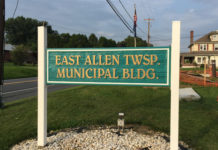The Northampton Area School District met on Thursday, June 16 for a community meeting on the district’s elementary school options and facility improvements. NASD Superintendent Joseph Kovalchik and D’Huy Engineering, Inc. President Arif Fazil led the presentation before opening up the discussion to residents’ questions.
Superintendent Kovalchik began the presentation with the history of the district’s capital plan, which was last updated in 2018 and was developed to address the district’s current facility needs. The first part of the plan was the completion of the middle school in 2016, and the second was Lehigh Elementary School, which is due to be finished this year. The remaining district facilities that need to be addressed include Moore Elementary School, Franklin Elementary School, the Washington technology building, and the District Administration Building.
The Capital Maintenance Plan is an assessment of the conditions of existing school district buildings and allows the district to look at renovation versus replacement costs. As outlined in the plan, the four above-mentioned buildings exceed 100% of the total capital improvement costs, meaning these buildings should be evaluated for program requirements and efficiency improvements and be considered for replacement due to the percentage of necessary renovations exceeding 100%.
In December 2019, the district hired FutureThink to provide an independent analysis of the school district without any local influences. FutureThink gathered and compiled demographics, enrollment figures, projections, and came up with seven possible considerations for the district in terms of how to proceed with buildings and/or renovations given the projected student enrollment and demographics.
Superintendent Kovalchik pointed out that as of June 1, 2022, there are a total of 1,876 new homes that are either approved or are in the planning stage within the school district.
Fazil then addressed the functional capacity of the elementary schools, which is the number of students that a school can reasonably accommodate to deliver the educational program whereas the functional capacity of kindergarten classrooms is 20 students, and the functional capacity of all other grades is 25 students per classroom. Fazil also noted that schools should aim for 80-90% functional capacity to be the most efficient.
Current elementary school functional capacities in the district have an average total of 90%, with George Wolf being at 90% functional capacity, Lehigh at 75%, Moore at 91%, Siegfried at 99%, and Franklin at 107%.
Taking into consideration the functional capacity of elementary school classrooms in the district, FutureThink reassigned the elementary boundaries using transportation (distance and time students are on buses) and school enrollment projections versus functional capacity to capture the most efficient distribution of students in its seven options listed for the district.
Option A was listed as the status quo with all buildings open and no changes made.
Option B proposed closing Franklin Elementary and redistributing students to achieve a 94% functional capacity for the district.
Option C proposed building the new elementary school on the Route 329 and Seemsville Road property that the district bought in 1995 for $227,500 from the Commonwealth of Pennsylvania, which would create a 71% functional capacity for the elementary schools in the district.
Option D proposed building the new elementary school and closing Franklin Elementary with a projected functional capacity of 74%.
Option E and F proposed building the new elementary school and closing Moore Elementary, with both options having a proposed functional capacity of 83%.
Lastly, Option G proposed building the new elementary school and closing Franklin and Moore Elementary for an 86% functional capacity.
Option G was recommended by FutureThink in order to best balance capacities where students live and current school locations. Other listed benefits of Option G include providing growth and adjustment flexibility for functional capacity, providing similar and equivalent programs at all elementary schools in the district, sizes of schools will provide efficiencies such as cost savings, and schools are located strategically to accommodate identified growth.
Fazil identified that other parameters for the options include limited availability for building at Moore Elementary and no availability at Franklin Elementary, Washington technology building, and the Administration Building.
The estimated costs of closing Franklin Elementary, renovating Moore Elementary, building an addition onto George Wolf Elementary, and replacement of both the Administration Building and the Washington technology building came to a total cost of $69,314,690. In contrast, the estimated costs of closing Franklin Elementary, the Washington technology building, and the Administration Building, while building the new elementary school with another building on the site for a new administration and technology building would be $70,363,000. This option does not include any work at the other existing elementary schools but does account for a usage review of Moore Elementary. This preliminary budget estimate accounts for the 149,410 square footage of the new elementary school and education center (with approximately 6,650 square feet of basement space) at $349 per square foot for a total of $52,089,030, plus $5,000,000 site construction for a combined total of $57,089,030. Soft costs including contingency is estimated at $12,156,970 and miscellaneous other costs for moving and phasing are estimated to be $1,390,000, for a project total of $70,363,000.
The projected transportation impact that opening the new elementary school, closing Moore Elementary and Franklin Elementary, and redistricting students proposed 50 buses for the district, which would only call for the addition of one more bus, will reduce the current 321.3 total mileage by 16.3 miles, reduce the current 942.8 minutes total by 80.8 minutes, and have a projected net cost of $120,000. The transportation impact of opening the new school and only closing Franklin Elementary projected 51 buses needed, reducing mileage by 9.4 miles and adding 62.3 total minutes for a net cost of $180,000, whereas opening the new school and only closing Moore Elementary would project 48 buses needed for the district, reducing mileage by 14.3 miles and reducing total minutes by 76.4 minutes for a net cost of $60,000.
The district currently has 275.5 elementary employees, 9 Act 93, 180.5 teachers, and 86 support staff for a total cost of $29,057,509.50. The personnel impact of only closing Franklin projects 271 elementary employees, 9 Act 93, 184 teachers, and 78 support staff for a total cost of $29,149,307 (an increase of $91,797.50 to the current budget). Opening the new elementary school projects 303.5 elementary employees, 10 Act 93, 198.5 teachers, and 95 support staff for a total cost of $32,082,026.50 (an increase of $3,024,517). Opening the new school and closing Franklin projects 299 elementary employees, 10 Act 93, 195 teachers, and 94 support staff for a total of $31,599,649 (an increase of $2,542,139.50). Opening the new school and closing Moore projects 264.5 elementary employees, 9 Act 93, 177.5 teachers, and 78 support staff for a total cost of $28,304,598.50 (a decrease of $752,911). Last, opening the new school while closing Franklin and Moore projects 257 total elementary employees, 8 Act 93, 180 teachers, and 69 support staff for a total cost of $28,105,779 (a decrease of $951,730.50 from the current personnel costs). Therefore, opening the new elementary school and closing Franklin and Moore would reduce the total elementary employees in the district by 18.5 employees, 1 Act 93, .5 teachers, and 17 support staff.
Many residents wanted to know where the district is getting the money to fund these projects. NASD Business Administrator Matthew Sawarynski stated the NASD current debt is $126 million and with no additional borrowing this debt is projected to be paid off in 2040, whereas adding the elementary school project will only add six years onto that debt service. Jamie Doyle from PFM Financial Advisors added that the district’s current debt service is a wrap-around debt service structure and that the district has “done a good job of managing the debt,” and that this provides a lot of flexibility for future needs.
Sawarynski stated that as of June 30, 2022, the district’s remaining borrowing capacity is approximately $114.5 million. The $70.4 million project would add about $2.3 million of debt service after it is fully phased in over the course of four years, which includes personnel savings from closing Moore and Franklin of $950,000 annually and $270,000 of annual bond refinancing savings.
Sawarynski added that the average taxpayer impact would be $105 over four years or an average of $26.25 a year ($2.19 a month) based on the average residential assessment of $54,600, which is 50% of taxpayers. This average residential assessment is not based on the fair housing market value of a home.
Sawarynski also added that the district generated $6 million in the last three years from warehouse tax appeals, and the revenue projections presented don’t account for the revenue that will be generated from Jaindl’s five new warehouses that are going to be built. Superintendent Kovalchik also chimed that when FedEx was first built the district generated $1 million in property taxes from them, but after a warehouse tax appeal, they now pay close to $2 million a year.
Residents also wanted to know how the district is able to build an elementary school on this property even though it was previously deemed unsuitable, which changed when the district got conditional zoning approval by East Allen Township in October 2021 to build an elementary school on the site. Since the site is zoned AG (Agricultural) and C (Conservation), the school was permitted as conditional use of agricultural land.
A traffic impact study is currently being coordinated with PennDOT and East Allen Township and is in progress. Other land development progress lists water service that is being coordinated with East Allen Township, Allen Township, and the Bethlehem Water Authority. Sewer service is also being coordinated with East Allen Township, Allen Township, and the Northampton Borough Municipal Authority, and submissions are being prepared for East Allen Township, Northampton County Conservation District, and the Lehigh Valley Planning Commission, the design phase and stakeholder input is in progress.
Current site development includes $11 million of infrastructure improvements that have already been completed by others such as the Route 329/Seemsville Road Intersection construction, a traffic light was installed at the intersection, utilities to district property, storm water management, and access points to district property have also been taken care of.
Site maps presented the proposed layout of the new school and education building, which included separate bus and vehicle entrances, parking for 200 vehicles, a bus drop-off zone that can accommodate 18 buses, an additional 70 parking spaces for events, complete emergency vehicle access around the building, and separate drop-off area for Y-care. The site and building progress maps showed that the proposed placement of the administration and technology building will be 380-feet from Seemsville Road and that the elementary school will be 555-feet from Seemsville Road and 1,230-feet from Route 329.
The next steps and projected schedule of the project include completing documents in preparation for bidding through December 2022, the bidding phase from December 2022 through February 2023, and the Board of School Directors will vote to accept low bids in March 2023. Should the board decide to move forward with the projects, the construction phase of the elementary school and education building will occur April 2023 through June 2025 for a 2025-2026 school year occupation.
Superintendent Kovalchik pointed out the 329 site is a viable option for the district because it offers no disruption to the current learning environment, the district already owns the property, it addresses the four district facilities in need of repair, it provides flexibility for future enrollment adjustments in identified growth areas, and because it has the least impact on personnel and transportation. The board will have to decide what they want to do with the four facilities outlined in the Capital Maintenance Plan, which could result in closing the buildings and/or selling them for funds. Kovalchik stated the board will be forced to make those decisions when the bids come in and predicts the district will eventually need five elementary schools to accommodate all K-5 students given the enrollment projections and proposed housing influx, however they cannot afford to do it all at one time.
Many residents asked questions about the cost efficiency of renovations and facility improvements, but recommendations by FutureThink for cost efficiency are based upon option G: building the new elementary school and administration/IT building, closing the current Administration Building, closing the Washington technology building, closing Franklin Elementary, and closing Moore Elementary, however none of those decisions have been formally made at this time.
Residents in the entire 98-miles of Northampton School Area District will be affected by the outcome of this project due to the redistricting of students throughout a large portion of the district. Superintendent Kovalchik noted the new elementary school boundaries will be on the district website soon and there will be a tool for residents to type their address in and see which elementary school their children will attend with the proposed redistricting.
Some of the Northampton residents’ concerns had to do with the tractor trailer and dump truck traffic that has recently increased and will continue to do so with the five warehouses Jaindl will be building. Sharif noted the traffic study can be made public after it is conducted.
Many residents were also worried about the current economy and inflation costs, which Sharif stated have been factored into the proposed costs already. Sharif added that the construction costs won’t be fully known until the bids for the project come in, but that once a lump sum bid is approved, it is a fixed bid, so there won’t be any cost increases unless there are unforeseen conditions (inflation not being an unforeseen cost). Current projected construction costs were compiled using data from construction costs in March 2022 and account for a 15% inflation factor.
Several residents stated they didn’t believe this is the right time for the project and wanted to know if the project could be put off or pushed back to a later date, but due to the conditional approval of the land, the degradation of the four buildings in the Capital Plan, and the district’s current debt service ratio, the district will move forward with the project, which is due to open for bidding at the end of the year. The Northampton School Board will vote to accept bids in March 2023, when it is likely they will have to decide what to do with the remaining buildings outlined in the Capital Plan.
Any questions that residents have may be sent to the school district via email at facilities@nasdschools.org. More information will also be made available to the public on the district website in the coming week.








